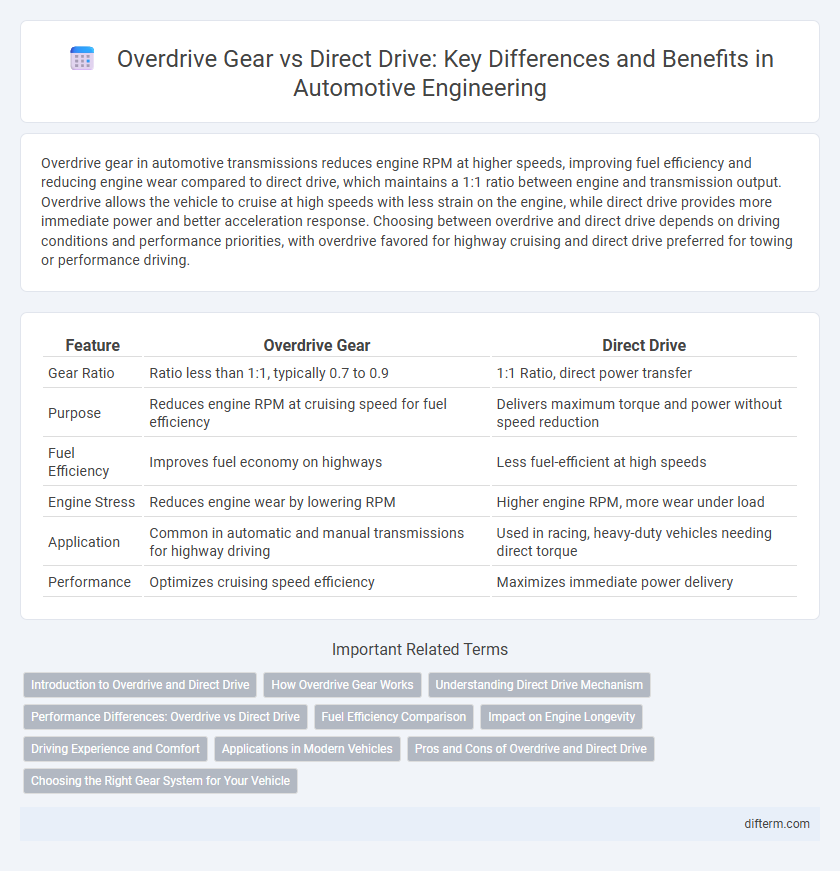Overdrive gear in automotive transmissions reduces engine RPM at higher speeds, improving fuel efficiency and reducing engine wear compared to direct drive, which maintains a 1:1 ratio between engine and transmission output. Overdrive allows the vehicle to cruise at high speeds with less strain on the engine, while direct drive provides more immediate power and better acceleration response. Choosing between overdrive and direct drive depends on driving conditions and performance priorities, with overdrive favored for highway cruising and direct drive preferred for towing or performance driving.
Table of Comparison
| Feature | Overdrive Gear | Direct Drive |
|---|---|---|
| Gear Ratio | Ratio less than 1:1, typically 0.7 to 0.9 | 1:1 Ratio, direct power transfer |
| Purpose | Reduces engine RPM at cruising speed for fuel efficiency | Delivers maximum torque and power without speed reduction |
| Fuel Efficiency | Improves fuel economy on highways | Less fuel-efficient at high speeds |
| Engine Stress | Reduces engine wear by lowering RPM | Higher engine RPM, more wear under load |
| Application | Common in automatic and manual transmissions for highway driving | Used in racing, heavy-duty vehicles needing direct torque |
| Performance | Optimizes cruising speed efficiency | Maximizes immediate power delivery |
Introduction to Overdrive and Direct Drive
Overdrive gear in automotive transmissions enables the engine to operate at lower RPMs while maintaining higher vehicle speeds, improving fuel efficiency and reducing engine wear. Direct drive refers to a 1:1 gear ratio where the engine's output shaft is directly connected to the drive wheels, providing maximum power transfer and acceleration. Understanding the distinction between overdrive and direct drive is essential for optimizing vehicle performance and fuel economy.
How Overdrive Gear Works
Overdrive gear reduces engine RPM by increasing the transmission's output speed beyond the input speed, allowing the vehicle to cruise efficiently at high speeds with lower engine strain. This gear arrangement improves fuel economy and decreases engine wear by enabling the engine to run at lower revolutions per minute during highway driving. In contrast, direct drive maintains a 1:1 ratio, meaning engine and transmission output speeds are equal, providing optimal power during acceleration but less fuel efficiency at sustained high speeds.
Understanding Direct Drive Mechanism
Direct drive mechanisms in automotive transmissions eliminate intermediary gears, enabling power to transfer directly from the engine to the drivetrain, enhancing efficiency and reducing energy loss. Unlike overdrive gear systems that increase output speed beyond input speed for fuel economy, direct drive maintains a 1:1 gear ratio for optimal torque delivery and performance. This setup is common in manual transmissions and some automatic systems, offering durability and improved acceleration response in various driving conditions.
Performance Differences: Overdrive vs Direct Drive
Overdrive gear improves fuel efficiency and reduces engine RPM at high speeds by allowing the output shaft to rotate faster than the input shaft, resulting in quieter operation and lower wear. Direct drive transmits power at a 1:1 ratio, delivering optimal torque and acceleration for better performance during city driving or towing. Overdrive excels in highway cruising, while direct drive offers superior responsiveness and power delivery in demanding conditions.
Fuel Efficiency Comparison
Overdrive gear reduces engine RPM at higher speeds, significantly improving fuel efficiency by lowering fuel consumption compared to direct drive. Direct drive maintains a 1:1 ratio, which can lead to higher engine speeds and increased fuel use during highway cruising. Vehicles equipped with overdrive transmissions typically achieve better mileage, especially in steady-state highway conditions, due to reduced engine load and optimized power delivery.
Impact on Engine Longevity
Overdrive gear reduces engine RPM at high speeds, minimizing wear and heat generation, which significantly enhances engine longevity. Direct drive maintains a 1:1 gear ratio, causing higher engine speeds that increase mechanical stress and accelerate component fatigue. Choosing overdrive gear supports sustained engine health by lowering operational strain during long-distance driving.
Driving Experience and Comfort
Overdrive gear enhances driving experience by reducing engine RPM at higher speeds, leading to smoother acceleration and improved fuel efficiency, which increases overall comfort during long-distance travel. Direct drive provides a more immediate power transfer with minimal drivetrain loss, offering better responsiveness and control, especially in urban driving conditions. The choice between overdrive and direct drive significantly impacts ride smoothness and driver fatigue, balancing performance with comfort based on driving environment.
Applications in Modern Vehicles
Overdrive gear in modern vehicles reduces engine RPM at high speeds, improving fuel efficiency and lowering emissions, making it ideal for highway cruising and long-distance drives. Direct drive provides a 1:1 ratio for maximum power transfer, enhancing acceleration and performance in city driving and off-road applications. Hybrid systems often integrate both to balance fuel economy with responsive power delivery in diverse driving conditions.
Pros and Cons of Overdrive and Direct Drive
Overdrive gear reduces engine RPM at higher speeds, improving fuel efficiency and lowering engine wear, but can cause reduced acceleration and torque. Direct drive offers better power transfer and acceleration by maintaining a 1:1 gear ratio, though it results in higher RPMs and increased fuel consumption during highway driving. Choosing between overdrive and direct drive depends on balancing fuel economy with performance needs and driving conditions.
Choosing the Right Gear System for Your Vehicle
Selecting the right gear system for your vehicle depends on factors such as fuel efficiency, driving conditions, and engine performance. Overdrive gear reduces engine RPM at high speeds, enhancing fuel economy and minimizing wear on engine components, making it ideal for highway driving. Direct drive, with a 1:1 gear ratio, delivers maximum power and responsiveness, suitable for towing, heavy loads, or performance-oriented vehicles.
Overdrive gear vs Direct drive Infographic

 difterm.com
difterm.com